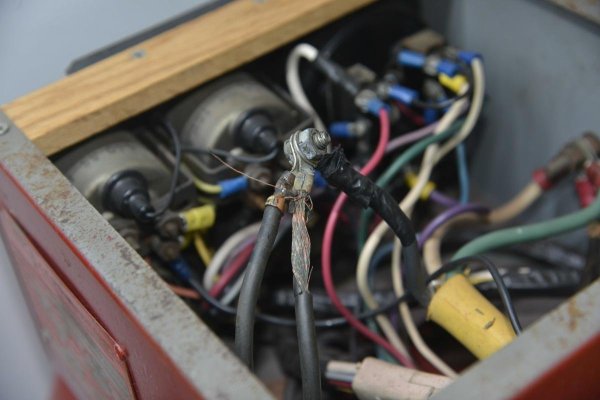STB
Guru
Hi all,
So, some may remember my earlier post about a ghost reverse polarity light. I got back on that boat this week, but to trouble shoot different issues that are a higher priority for the owner.
Initially, the port bow light quit working. Then the starboard bow light.
A 2-conductor 12vdc power cable ran from the panel forward where it forked off to the two lights via butt connectors that acted as 1:2 splitters.
The cable leading to the port bow light was seemingly of 1981 vintage, stranded, and untinned, but labelled as "boat" cable. The strands seemed brittle, dull, coated in a black border substance that tested as high resistance. Cutting back didn't help. It was all like that, even a foot in. I directed it be replaced.
I was called back the next day. Same symptoms, but this time the port starboard light. Same problem. The positive wire for the starboard branch had actually broken and the insulation around it stretched, leading to an invisible gap in the wire, I assume from being pulled at while the port wires were serviced. I directed that it be replaced and that the feed cable be replaced as soon as possible. I've been told the problem was resolved by replacing the starboard cable and that the replacement of the feed is on "the list".
For the curious, the boat is a 1981 C&C sailboat.
I, personally, don't think I've ever before seen a marine grade stranded wire get so brittle it broke inches from the end, and show brittleness feet in.
My question is this, how common is it for marine grade stranded wire, from the days before tinning, to get that bad along the whole length of the wire vs just near the ends?
(I hope to update the reverse polarity thread soon, when the owner let's me get back to debugging that...)
So, some may remember my earlier post about a ghost reverse polarity light. I got back on that boat this week, but to trouble shoot different issues that are a higher priority for the owner.
Initially, the port bow light quit working. Then the starboard bow light.
A 2-conductor 12vdc power cable ran from the panel forward where it forked off to the two lights via butt connectors that acted as 1:2 splitters.
The cable leading to the port bow light was seemingly of 1981 vintage, stranded, and untinned, but labelled as "boat" cable. The strands seemed brittle, dull, coated in a black border substance that tested as high resistance. Cutting back didn't help. It was all like that, even a foot in. I directed it be replaced.
I was called back the next day. Same symptoms, but this time the port starboard light. Same problem. The positive wire for the starboard branch had actually broken and the insulation around it stretched, leading to an invisible gap in the wire, I assume from being pulled at while the port wires were serviced. I directed that it be replaced and that the feed cable be replaced as soon as possible. I've been told the problem was resolved by replacing the starboard cable and that the replacement of the feed is on "the list".
For the curious, the boat is a 1981 C&C sailboat.
I, personally, don't think I've ever before seen a marine grade stranded wire get so brittle it broke inches from the end, and show brittleness feet in.
My question is this, how common is it for marine grade stranded wire, from the days before tinning, to get that bad along the whole length of the wire vs just near the ends?
(I hope to update the reverse polarity thread soon, when the owner let's me get back to debugging that...)

